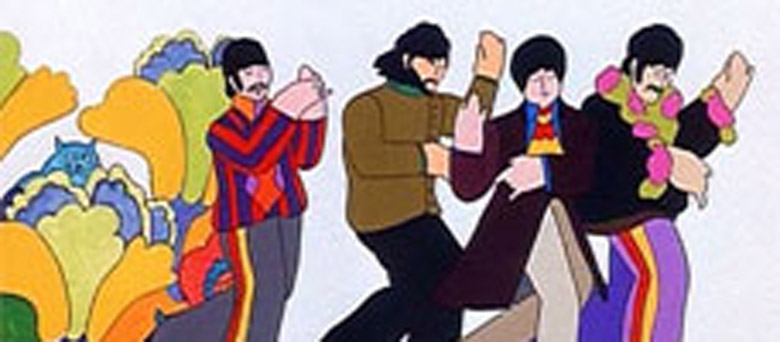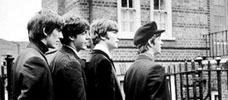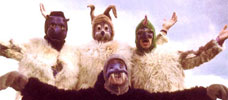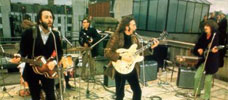Reviews
George Dunning
UK, 1968
Credits
Review by Megan Weireter
Posted on 08 September 2009
Source Apple VHS
Categories The Beatles on Film
With each film that they released through the mid-‘60s, the Beatles became less human and more superhuman, less real and more hyper-real, in the public imagination. So it’s interesting that, after the weirdness and excess of Magical Mystery Tour, the Beatles would literally be transformed into cartoons for Yellow Submarine.
Of course, the switch to animation also suited their wishes at the time. Still under contract to United Artists for a third movie, the Beatles— who hadn’t enjoyed making Help!—and who had been stunned by the negative critical reception of Magical Mystery Tour - were not in the mood to start in on another movie to fulfill their obligation. The idea for an animated movie actually predates both those films, though. Producer Al Brodax of King Features, who was responsible for the odious The Beatles Saturday morning cartoon show of the mid-‘60s (which the Beatles rightly loathed), had always hoped to parlay that deal into a full-length animated film, and there seems to have been a treatment for Yellow Submarine as early as 1966. Though never enthusiastic about the idea, the Beatles signed off on it and hoped to thereby be done with movies for good. (United Artists, unfortunately, held that Yellow Submarine didn’t count as a new Beatles movie, because the Beatles didn’t participate in the making of it at all, not even lending their own voices to the characters. It was Let It Be that finally met the need for a new film.) Although Yellow Submarine had no Beatle involvement in its creation, it became a key part of the Beatles’ mythology, and the Beatles themselves loved the finished product so much that they’ve taken ownership of it pretty much from the time of the film’s release. (It’s now under the Apple label along with the rest of the Beatles’ canon.) Hence, it’s become canonical, and deserving of coverage here.
With the Beatles’ blessing, the filmmakers conceived of a psychedelic fantasy for children, or, if you prefer, a children’s movie that young adult Beatles fans would also enjoy. Yellow Submarine is in a way a conventional story of good conquering evil, but it’s also a flimsy hippie parable with a mission to spread love and peace and flowers and music. Inevitably, it looks dated now. But if Yellow Submarine is a period piece, it’s a very beautiful period piece to look at—and its core storyline, such as it is, is so familiar that it can still entertain kids and adults alike. And I would argue that without the film’s embrace of psychedelic culture, its whole internal logic, or lack of logic, wouldn’t have been possible. It’s rare to see a mainstream movie that revels so much in unchecked imaginative power. But without the ridiculous Yellow Submarine imagination, there would be no Kinky Bootbeasts, no Foothills of the Headlands, no Apple Bonkers. The universe that’s been created here is so demented and delightful that I for one don’t care if a hippie sensibility underlies it all—or, for that matter, if drugs were involved its creation. It’s all beside the point, provided the film stands up by its own merits.
The lunacy begins in Pepperland, a magical paradise where love and music reign and everyone’s happy all the time—until the Blue Meanies attack, that is, silencing the music made by local sensation Sgt. Pepper’s Lonely Hearts Club Band and bonking the citizenry into a stony silence. Somehow, Young Fred manages to escape in Pepperland’s magical yellow submarine, sailing upwards through the sky and into our world to try to find help. He finds the Beatles and brings them back into Pepperland, but not before they have several adventures on the way as they travel through the many Seas in between here and there—Seas being not literal oceans, but landscapes for the film’s artists to let their imaginations run wild in, like the Sea of Time, the Sea of Monsters, and the Sea of Nothing. They also manage to pick up Jeremy, a furry mustached creature who will prove useful. When they do get to Pepperland, it’s the work of a morning to find instruments, free Sgt. Pepper’s band from their trap, and sing and play until the Blue Meanies are converted to the happy hippie-dippie cause.
The richness of middle-period Beatles music always seems at home in this world and in this story. In their distaste for participation in the project, the Beatles provided only a bare minimum of new songs: just four originals, all of them scraps left over from past albums.1 Thus the filmmakers used already-released tracks from recent albums for the rest of the film, preferring the songs from Sgt. Pepper most of all. They were able to squeeze a lot of songs in Yellow Submarine this way—I count eleven distinct musical sequences, and there are even more songs referenced briefly here and there. More than any of the previous films, this one is driven by musical scenes, which makes sense, considering music can literally save worlds within the film’s mythos. It also allows the artists that much more creative license, as each song is illustrated in sometimes dramatically different ways.
At the time of the film’s release, the art and animation were nothing short of groundbreaking. The movie is spellbindingly beautiful even now, rich with color and absurdity. What’s interesting is that neither creative director Heinz Edelmann (a German illustrator known for poster art) or director George Dunning (an animator who had worked on The Beatles cartoon show but who had mainly produced advertisements) ever did a feature film again—which clearly helps keep Yellow Submarine distinctive historically. Though Dunning supervised the huge team of artists needed to create and animate these lush sequences, the look is largely Edelmann’s vision,2 heavily influenced by the psychedelic poster art that was so popular at the time. Most interesting to me is the love that the movie has for pulling imagery from virtually any source at all. The quasi-Victorian illustration in the Pepperland scenes, the random assortment of licensed comic book characters that fly through the Beatles’ house, the very modern strobe effect in the “Only a Northern Song” sequence, or the fancing colors in “Lucy in the Sky with Diamonds” scene (which I’ve read described as “Kandinsky on acid”): Yellow Submarine is so in love with every form of art that it seems downright schizophrenic.
The Liverpool that Yellow Submarine depicts, however briefly, stands in sharp contrast to the paradise of Pepperland: it’s a bricked-over nightmare full of bored or tearful people, repeating the same motions again and again. As “Eleanor Rigby” plays, the yellow submarine goes unnoticed by the city’s zombie-like citizens—except, of course, for Ringo, who has ventured outside only to stand on a street corner and say “woe is me.” (The policeman he meets won’t believe that there’s a yellow submarine following Ringo, unsurprisingly—no one in this city would believe anything out of the ordinary—although the cop’s own loneliness is expressed in the brief scene in which he unsuccessfully tries to lure a cat over to him.) The yellow submarine follows Ringo to the gigantic house where the Beatles all live—although to call it a “house” is inaccurate, since it amounts to a whole fantasy world in which the Beatles play. Indeed, you get the sense that the Beatles never leave. They seem to have given up on the people out in Liverpool, preferring to live in the elaborate dreams they’ve constructed around themselves. George’s tagline, “It’s all in the mind,” sums it up perfectly—they’re living in their own minds, really, ignoring everything outside. In the house, Ringo drives a car (which George can make change colors), George meditates at the top of a gigantic mountain, John turns himself into Frankenstein’s monster, and Paul seems to just hang out in rooms full of clapping, cheering fans. Each door opens up into a whole new world occupied by bizarre characters, such that the house is clearly without boundaries—it’s an entirely magical space. Pepperland might be a magical world, but the Beatles have managed to build one of their own right there in miserable Liverpool, all by themselves, just by being Beatles. (Maybe they are the lonely people.)
Young Fred talks the boys into helping Pepperland out easily enough, but it just makes you wonder: why have the Beatles never saved their own world, if they are so powerful? I think it’s because they just don’t even belong in their own world. In their movies, the Beatles frequently function as some kind of “other,” but never more so than here. In Pepperland, they meet their doppelgängers, the members of Sgt. Pepper’s Lonely Hearts Club Band, and each pair bonds with each other immediately. They’ve come home, in a way. Pepperland was where these Beatles, these magical beings, were always supposed to live. The movie insinuates that the Beatles are literally not of our world—they really are gods living among us. Yellow Submarine thus takes the otherness of the Beatles up to its maximum level. It’s not just the Beatles themselves, either—it’s their music that has magic to it. They defeat the Blue Meanies not with any superpowers, but just by singing and playing their own songs. (Even in the scene in the Sea of Nothing, in which they take Jeremy with them, the Beatles start singing “Nowhere Man” and suddenly are walking through the white space with trails of gorgeous color behind them. It’s a clear visual representation of what their music can do.) The message is clear—this music can end oppression. If it hasn’t opened your mind yet, it’s because you aren’t listening properly.
As different as the aesthetic and approach is compared to the Beatles’ past movies, Yellow Submarine shares one thing in common with at least A Hard Day’s Night and Help!: the dialogue’s density of wit. Like the others, this one features dialogue so thick with comedy and inside jokes that it’s hard to catch them all the first time, so that with each viewing you notice another hilarious line. But in Yellow Submarine there are a couple of crucial differences. One is that, arguably, the dialogue here has less “wit” and more “puns”—though if you like puns, there are doozies in here. (The Bicyclops moment is one of my favorites.) And in a movie for children, it seems almost like a kid-friendly adaptation of a generally recognized Beatle-film style, and it works quite well. More notable is that so much of the humor is self-referential. Inside jokes are thrown out to fans like treats—Paul telling Ringo that “you’re not half the lad you used to be,” John’s pronouncement that he is the ego man (goo goo ga choo), Jeremy explaining that the Sea of Holes has enough holes to fill the Albert Hall, and so on. This is a new element to Beatles films, and it only highlights the level of the Beatles’ own notoriety. Only a movie made without the Beatles’ own input could possibly have gotten away with having the band members recite their own lyrics as jokes without it being annoying. These moments remind us that this film, unlike the others, isn’t the Beatles giving fans a new work of art: it’s an homage to the Beatles by and for fans. They are on screen primarily to be celebrated and lauded.
Of course, even while the myth of the Beatles as benign wizards, or perhaps gods, was being propagated by Yellow Submarine, the real people behind the myth were growing apart thanks to disagreements by creative and financial. Yellow Submarine was, in a way, the last gasp of the Beatles as cultural myth. But there wouldn’t possibly have been anywhere else for the myth to go anyway. In accordance with their newly embraced back-to-basics aesthetic, the Beatles’ final movie would be Let It Be, as stripped-down a documentary as they could make, the anti-Yellow Submarine. But for a little while, anyway, the fairy tale would go on. Even today, it’s as good a fairy tale as any.
- Though this is generally accepted to be the reason why there are only four original songs—sheer lack of enthusiasm on the Beatles’ part—Paul McCartney has offered another explanation. According to him, once the band realized that the movie would be so _Sgt. Pepper_-ish and so psychedelic, they thought it would be better for them to have old songs anyway, since they themselves had already moved on to something new, writing songs with a leaner aesthetic that wouldn’t fit the film as well. ↩
- Peter Max is frequently mentioned in connection with the art of _Yellow Submarine_, but in fact he had nothing to do with the film. Although I’m no expert on this, I’ve read that it might be more correct to say that Edelmann influenced Max rather than the other way around. ↩
More The Beatles on Film
We don’t do comments anymore, but you may contact us here or find us on Twitter or Facebook.








